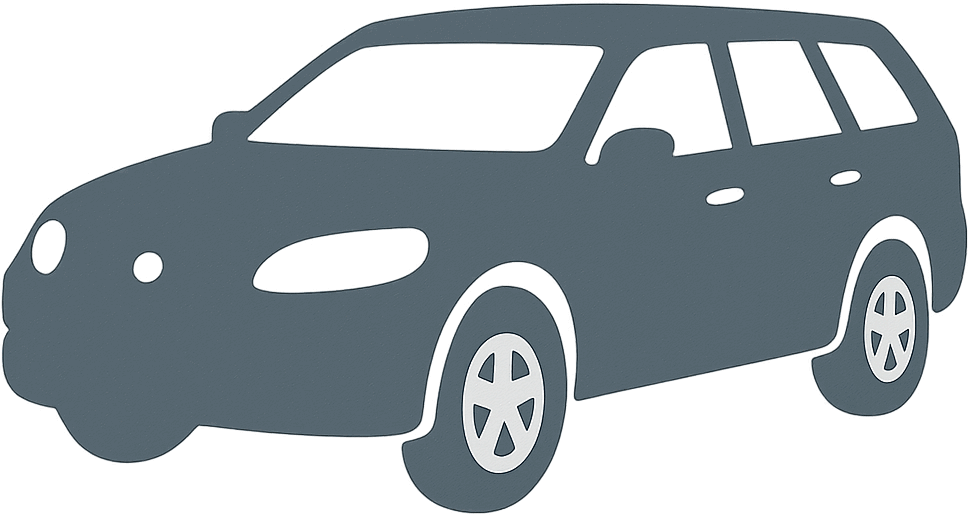 1987 GAZ 2414 Dimensions, Size & Specs
1987 GAZ 2414 Dimensions, Size & Specs
Measurements of the 1987 GAZ 2414, engineered for optimal performance and comfort
| Dimensions | |
|---|---|
| Length: | 4735 mm186.4 in15.5 ft |
| Width: | 1800 mm70.9 in5.9 ft |
| Height: | 1576 mm62.0 in5.2 ft |
| Weight Specifications | |
| Curb Weight: | 1540 kg3395 lbs |
| Tire Specifications | |
| Rims Size: | 14-inch rims:
|
| Tire Size: |
|
The GAZ 24 2414 station wagon, produced from 1987 to 1992, is a distinctive and practical vehicle offering from the Soviet era manufacturer GAZ. This generation of the GAZ 24 series combines the classic design cues with functional versatility, making it a notable option among station wagons of the late 1980s and early 1990s. Measuring 4735 mm (186.4 inches) in length, the 2414 model provides ample interior space and cargo capacity, ideal for families or utility purposes. The width spans 1800 mm (70.9 inches), allowing for comfortable seating arrangements and contributing to stable handling characteristics. With a height of 1576 mm (62 inches), this vehicle maintains a balanced profile that supports both aerodynamics and ease of access. The GAZ 24 2414’s curb weight stands at 1540 kg (3397 lbs), reflecting its robust build quality and structural integrity typical of vehicles from this era. This weight aids in delivering a solid driving feel, which was valued in diverse driving conditions. The car rides on 14-inch rims (5.5J x 14), fitted with 205/70 R14 tires, a specification that balances ride comfort with road grip. Overall, the GAZ 24 2414 station wagon remains an emblematic vehicle of its time, combining size, durability, and functional design to serve a variety of user needs in both urban and rural environments.
Discover the standout features that make the 1987 GAZ 2414 a leader in its class
Have a question? Please check our knowledgebase first.
The GAZ 24 2414 station wagon, produced from 1987 to 1992, measures 4735 mm (186.4 inches) in length, 1800 mm (70.9 inches) in width, and 1576 mm (62.0 inches) in height. These dimensions make it a relatively large station wagon, providing ample interior space. Its size allows it to carry both passengers and cargo efficiently, which was typical for vehicles designed for versatility during that era. The vehicle's substantial length and width contribute to its road presence and stability, while the height supports higher headroom inside.
The GAZ 24 2414 has a curb weight of approximately 1540 kg (3395 lbs). This weight reflects the car's robust build quality and the necessity to support its station wagon body style, which includes more structural components compared to a sedan. A curb weight of this size can impact handling by providing a more stable ride on highways but potentially making the vehicle less agile in tight maneuvers. Additionally, a heavier weight generally means slightly reduced fuel economy, which was a common trade-off for cars of this type in the late 1980s and early 1990s.
Standard garages typically have interior dimensions around 2.4 to 3.0 meters (8 to 10 feet) wide and about 5.5 to 6.0 meters (18 to 20 feet) deep. Given the GAZ 24 2414's length of 4735 mm (4.735 meters or 15.5 feet) and width of 1800 mm (1.8 meters or 5.9 feet), it will generally fit comfortably into a standard garage with sufficient clearance on all sides. Drivers should still consider the additional space needed to open doors and maneuver around the vehicle, but overall, the car's dimensions are compatible with typical garage sizes.
The GAZ 24 2414 is essentially an evolution of the earlier GAZ 24 series but designed as a station wagon variant. While the core chassis and length are similar to previous sedans, the wagon body style and specific trims might slightly increase overall height and curb weight due to additional structural reinforcements and cargo area enhancements. For instance, the length remains close to 4735 mm (186.4 in), which aligns with the sedan’s design, but the added functionality of the wagon changes the vehicle's profile and utility. This generation focuses more on versatility without dramatically increasing size.
The GAZ 24 2414 comes equipped with 5.5J x 14 rims and 205/70 R14 tires. The 14-inch rim size combined with a 205 mm width and 70% tire sidewall height provides a balance between comfort and handling. The taller tire sidewall helps absorb road imperfections, enhancing ride comfort on rough or uneven surfaces, which is important for a vehicle like this used in diverse driving conditions. Additionally, the tire size ensures good ground contact, improving traction and stability but not compromising too much on fuel economy or driving dynamics.
While precise interior cabin and cargo volume figures for the GAZ 24 2414 are not commonly documented, the station wagon body style inherently provides increased cargo capacity compared to the sedan variants. With a length of 4735 mm and width of 1800 mm, the car offers a spacious passenger compartment with sufficient legroom and headroom, especially given its 1576 mm height. The design is well-suited for families or those needing to transport larger items or luggage, as the extended rear area enables flexible cargo loading and better utility than traditional sedans.
In the late 1980s and early 1990s, many station wagons were designed with practicality and durability in mind, similar to the GAZ 24 2414. Its length of 4735 mm and curb weight of 1540 kg place it in the mid to larger range among station wagons of that period. Competing models like certain European or American wagons might be slightly larger or lighter depending on construction materials and purpose. The GAZ 24 2414 is robust, prioritizing strength over lightness, making it comparable to contemporaries that emphasized reliability and cargo capacity for family and utility uses.
With its length of nearly 4.7 meters (15.5 feet), width of 1.8 meters (5.9 feet), and weight exceeding 1500 kg, the GAZ 24 2414 station wagon is moderately sized but not compact by urban vehicle standards. While it offers solid interior space, maneuvering in tight city environments can be somewhat challenging compared to smaller cars, especially in narrow parking spots or congested streets. Drivers will benefit from practicing spatial awareness, but the vehicle's design does not impede typical urban driving when reasonable caution is observed.
The GAZ 24 2414’s fuel efficiency aligns with typical vehicles of its class and era, which prioritized durability and utility over fuel economy. Its curb weight of 1540 kg and somewhat large dimensions indicate moderate fuel consumption. Given the technology and engine options of its time, it is less fuel-efficient compared to modern cars but comparable to other station wagons from the late 1980s. Drivers should expect moderate consumption suitable for the vehicle's robust performance and functional purpose rather than economy.
The primary difference lies in the body style: the GAZ 24 2414 is a station wagon, while other GAZ 24 models were traditionally sedans. This wagon design increases rear cargo capacity and offers more versatility, making it ideal for transporting goods and larger loads. The height (1576 mm) and overall structure are slightly different to accommodate this, as opposed to the sedan’s more streamlined profile. Both share mechanical components, but the wagon caters to buyers prioritizing utility and space without sacrificing much in driving dynamics or comfort.
Discover similar sized cars.

| Production: | 2003-2009 |
|---|---|
| Model Year: | 2003 |
| Length: | 4700-4715 mm185.0-185.6 in |
| Width: | 1760 mm69.3 in |
| Height: | 1525 mm60.0 in |

| Production: | 2005-2008 |
|---|---|
| Model Year: | 2006 |
| Length: | 4756 mm187.2 in |
| Width: | 1775 mm69.9 in |
| Height: | 1597 mm62.9 in |

| Production: | 1987-1992 |
|---|---|
| Model Year: | 1987 |
| Length: | 4735 mm186.4 in |
| Width: | 1800 mm70.9 in |
| Height: | 1576 mm62.0 in |

| Production: | 1987-1992 |
|---|---|
| Model Year: | 1987 |
| Length: | 4735 mm186.4 in |
| Width: | 1800 mm70.9 in |
| Height: | 1576 mm62.0 in |

| Production: | 1972-1987 |
|---|---|
| Model Year: | 1972 |
| Length: | 4735 mm186.4 in |
| Width: | 1800 mm70.9 in |
| Height: | 1576 mm62.0 in |

| Production: | 1972-1987 |
|---|---|
| Model Year: | 1972 |
| Length: | 4735 mm186.4 in |
| Width: | 1800 mm70.9 in |
| Height: | 1576 mm62.0 in |
